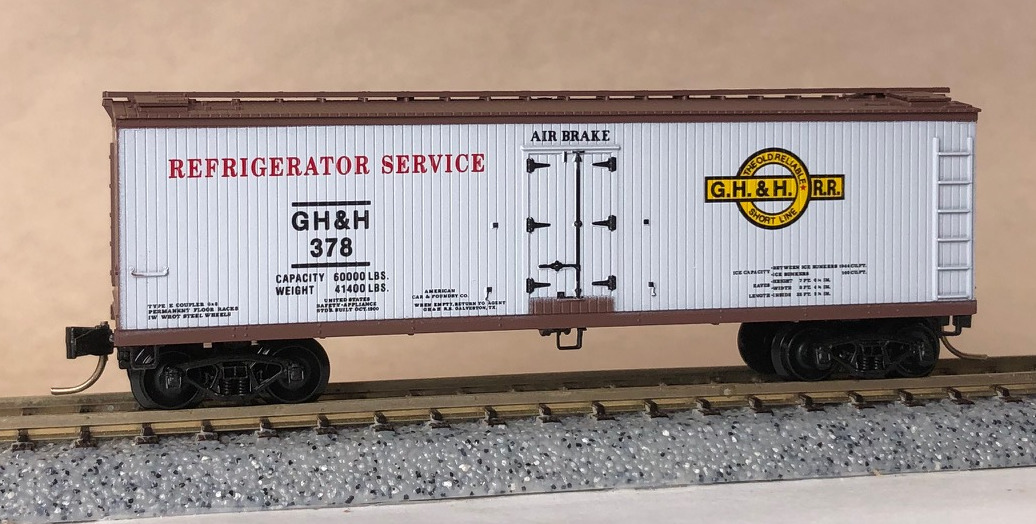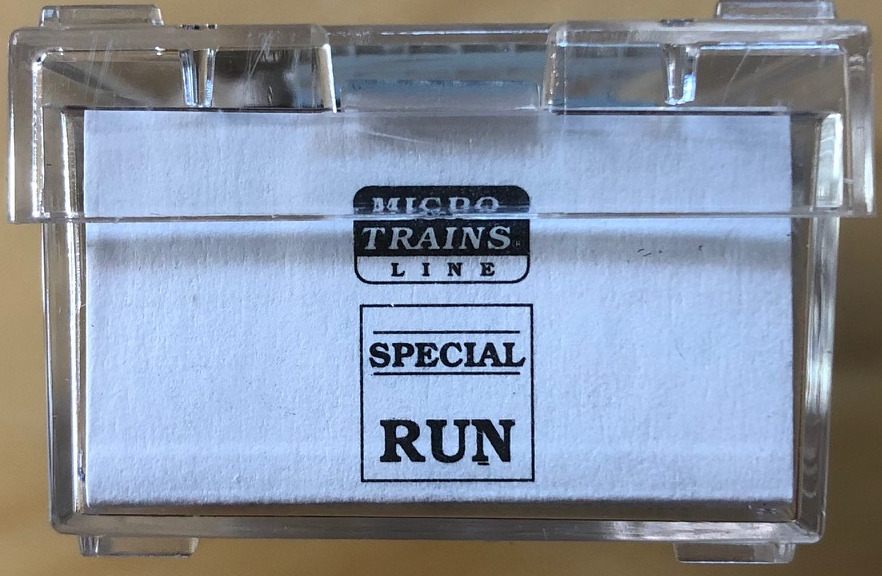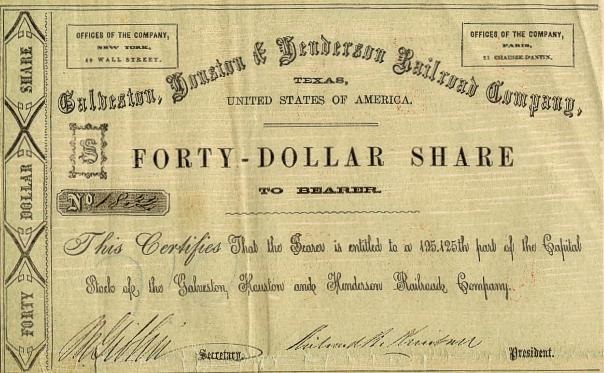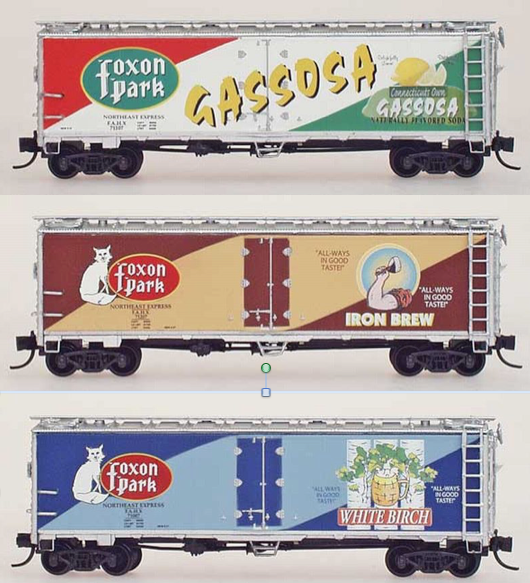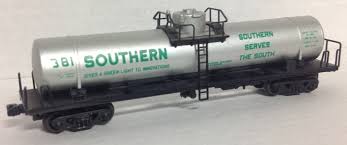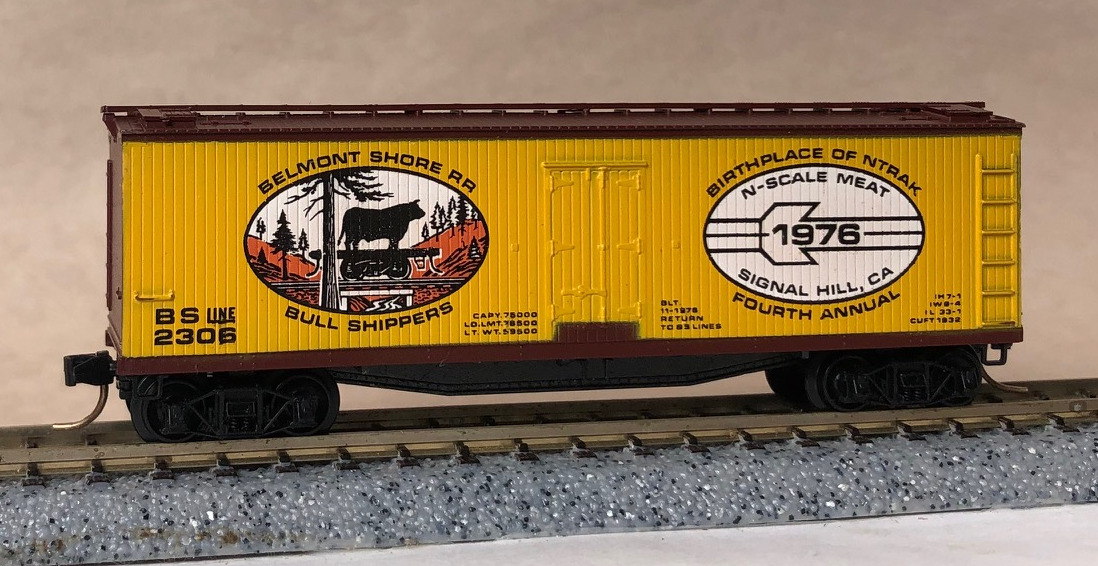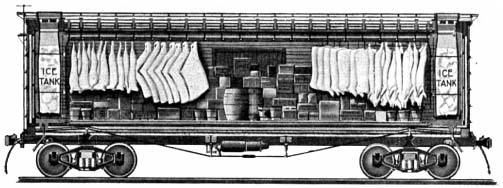Micro-Trains - NSC 93-01 - Reefer, 40 Foot, Wood Sheathed - Galveston Houston and Henderson - 378
| Commissioned By | Houston N-TRAK N Crowd |
| Production Type | Special Run |
| Stock Number | NSC 93-01 |
| Original Retail Price | $16.00 |
| Brand | Micro-Trains |
| Manufacturer | Micro-Trains Line |
| Body Style | Micro-Trains 047 Reefer Wood Sheathed 40 Foot Horizontal Brake |
| Prototype Vehicle | Reefer, Ice, Wood (Details) |
| Prototype | Reefer, 40 Foot, Wood Sheathed |
| Road or Company Name | Galveston Houston and Henderson (Details) |
| Reporting Marks | GH&H |
| Road or Reporting Number | 378 |
| Paint Color(s) | Light Gray |
| Print Color(s) | Black and Red |
| Additional Markings/Slogan | Refrigerator Service |
| Coupler Type | MT Magne-Matic Knuckle |
| Coupler Mount | Truck-Mount |
| Wheel Type | Injection Molded Plastic |
| Wheel Profile | Standard |
| Release Date | 1993-01-01 |
| Item Category | Rolling Stock (Freight) |
| Model Type | Reefer |
| Model Subtype | 40 Foot |
| Model Variety | Wood Sheathed, Horizontal Brake Wheel |
| Prototype Region | North America |
| Prototype Era | NA Era II: Late Steam (1901 - 1938) |
| Scale | 1/160 |
Model Information:
Horizontal Brake Wheel is equivalent to Side-Mounted Brake Wheel. The wheel itself is vertical.
Prototype History:
During the mid-19th century, attempts were made to ship agricultural products by rail. As early as 1842, the Western Railroad of Massachusetts was reported in the June 15 edition of the Boston Traveler to be experimenting with innovative freight car designs capable of carrying all types of perishable goods without spoilage. The first refrigerated boxcar entered service in June 1851, on the Northern Railroad (New York) (or NRNY, which later became part of the Rutland Railroad). This "icebox on wheels" was a limited success since it was only functional in cold weather. That same year, the Ogdensburg and Lake Champlain Railroad (O&LC) began shipping butter to Boston in purpose-built freight cars, utilizing ice for cooling.
The first consignment of dressed beef left the Chicago stock yards in 1857 in ordinary boxcars retrofitted with bins filled with ice. Placing meat directly against ice resulted in discoloration and affected the taste, proving to be impractical. During the same period Swift experimented by moving cut meat using a string of ten boxcars with their doors removed, and made a few test shipments to New York during the winter months over the Grand Trunk Railway (GTR). The method proved too limited to be practical.
The use of ice to refrigerate and preserve food dates back to prehistoric times. Through the ages, the seasonal harvesting of snow and ice was a regular practice of many cultures. China, Greece, and Rome stored ice and snow in caves, dugouts or ice houses lined with straw or other insulating materials. Rationing of the ice allowed the preservation of foods during hot periods, a practice that was successfully employed for centuries. For most of the 19th century, natural ice (harvested from ponds and lakes) was used to supply refrigerator cars. At high altitudes or northern latitudes, one foot tanks were often filled with water and allowed to freeze. Ice was typically cut into blocks during the winter and stored in insulated warehouses for later use, with sawdust and hay packed around the ice blocks to provide additional insulation. A late-19th century wood-bodied reefer required re-icing every 250 miles (400 km) to 400 miles (640 km).
From Wikipedia
The first consignment of dressed beef left the Chicago stock yards in 1857 in ordinary boxcars retrofitted with bins filled with ice. Placing meat directly against ice resulted in discoloration and affected the taste, proving to be impractical. During the same period Swift experimented by moving cut meat using a string of ten boxcars with their doors removed, and made a few test shipments to New York during the winter months over the Grand Trunk Railway (GTR). The method proved too limited to be practical.
The use of ice to refrigerate and preserve food dates back to prehistoric times. Through the ages, the seasonal harvesting of snow and ice was a regular practice of many cultures. China, Greece, and Rome stored ice and snow in caves, dugouts or ice houses lined with straw or other insulating materials. Rationing of the ice allowed the preservation of foods during hot periods, a practice that was successfully employed for centuries. For most of the 19th century, natural ice (harvested from ponds and lakes) was used to supply refrigerator cars. At high altitudes or northern latitudes, one foot tanks were often filled with water and allowed to freeze. Ice was typically cut into blocks during the winter and stored in insulated warehouses for later use, with sawdust and hay packed around the ice blocks to provide additional insulation. A late-19th century wood-bodied reefer required re-icing every 250 miles (400 km) to 400 miles (640 km).
From Wikipedia
Road Name History:
The GH&H completed their 50 mile line from Galveston to Houston, Texas in 1859. A trestle across Galveston Bay was completed the following year. They survived the Civil War intact, remaining in operation for the duration. After the war, the GH&H changed hands several times and acquired the Galveston & Houston Junction Railroad. In the 1880s, it fell into the hands of Jay Gould and his associates. He transferred ownership to his Missouri Kansas & Texas. However, MK&T did not yet reach Houston so MK&T leased it to International & Great Northern (another Gould holding.) However, Gould lost control of the MK&T in 1888 and five years later when MK&T reached Houston, they demanded the return of the GH&H from International & Great Northern. Arguing the lease was still valid, I&GN refused to turn it over. Seven years in the courts were resolved when MK&T agreed to sell a half interest in the GH&H to I&GN. This gave both trackage rights on the GH&H to Galveston.
In 1900 a hurricane destroyed the trestle across Galveston Bay and rather than rebuild it, GH&H acquired trackage rights over the Gulf Colorado & Santa Fe bridge that had survived the storm. This was replaced with a causeway in 1912.
In 1920, the arrangement changed between M-K-T and I-GN (both had since traded ampersands for hyphens.) The two would trade off operation of the GH&H mainline every year and the GH&H as an operating railroad would be reduced to terminal operations in Galveston. I-GN’s half later passed to Missouri Pacific. This arrangement remained in place until 1989 when M-K-T was merged into Missouri Pacific (by that time a paper railroad under Union Pacific.) With no more need for an independent terminal operator, the GH&H was dissolved.
In 1900 a hurricane destroyed the trestle across Galveston Bay and rather than rebuild it, GH&H acquired trackage rights over the Gulf Colorado & Santa Fe bridge that had survived the storm. This was replaced with a causeway in 1912.
In 1920, the arrangement changed between M-K-T and I-GN (both had since traded ampersands for hyphens.) The two would trade off operation of the GH&H mainline every year and the GH&H as an operating railroad would be reduced to terminal operations in Galveston. I-GN’s half later passed to Missouri Pacific. This arrangement remained in place until 1989 when M-K-T was merged into Missouri Pacific (by that time a paper railroad under Union Pacific.) With no more need for an independent terminal operator, the GH&H was dissolved.
Brand/Importer Information:
Micro-Trains is the brand name used by both Kadee Quality Products and Micro-Trains Line. For a history of the relationship between the brand and the two companies, please consult our Micro-Trains Collector's Guide.
Manufacturer Information:
 Micro-Trains Line split off from Kadee Quality Products in 1990. Kadee Quality Products originally got involved in N-Scale by producing a scaled-down version of their successful HO Magne-Matic knuckle coupler system. This coupler was superior to the ubiquitous 'Rapido' style coupler due to two primary factors: superior realistic appearance and the ability to automatically uncouple when stopped over a magnet embedded in a section of track. The success of these couplers in N-Scale quickly translated to the production of trucks, wheels and in 1972 a release of ready-to-run box cars.
Micro-Trains Line split off from Kadee Quality Products in 1990. Kadee Quality Products originally got involved in N-Scale by producing a scaled-down version of their successful HO Magne-Matic knuckle coupler system. This coupler was superior to the ubiquitous 'Rapido' style coupler due to two primary factors: superior realistic appearance and the ability to automatically uncouple when stopped over a magnet embedded in a section of track. The success of these couplers in N-Scale quickly translated to the production of trucks, wheels and in 1972 a release of ready-to-run box cars.
Micro-Trains Line Co. split off from Kadee in 1990 to form a completely independent company. For this reason, products from this company can appear with labels from both enterprises. Due to the nature of production idiosyncrasies and various random factors, the rolling stock from Micro-Trains can have all sorts of interesting variations in both their packaging as well as the products themselves. When acquiring an MTL product it is very important to understand these important production variations that can greatly enhance (or decrease) the value of your purchase.
Please consult our Micro-Trains Collector's Guide

Micro-Trains Line Co. split off from Kadee in 1990 to form a completely independent company. For this reason, products from this company can appear with labels from both enterprises. Due to the nature of production idiosyncrasies and various random factors, the rolling stock from Micro-Trains can have all sorts of interesting variations in both their packaging as well as the products themselves. When acquiring an MTL product it is very important to understand these important production variations that can greatly enhance (or decrease) the value of your purchase.
Please consult our Micro-Trains Collector's Guide
Item created by: gdm
on 2017-04-14 11:11:57
Last edited by: Alain LM on 2022-05-10 12:08:34
If you see errors or missing data in this entry, please feel free to log in and edit it. Anyone with a Gmail account can log in instantly.
Last edited by: Alain LM on 2022-05-10 12:08:34
If you see errors or missing data in this entry, please feel free to log in and edit it. Anyone with a Gmail account can log in instantly.


